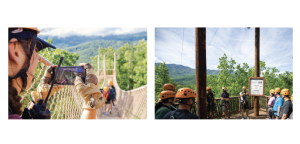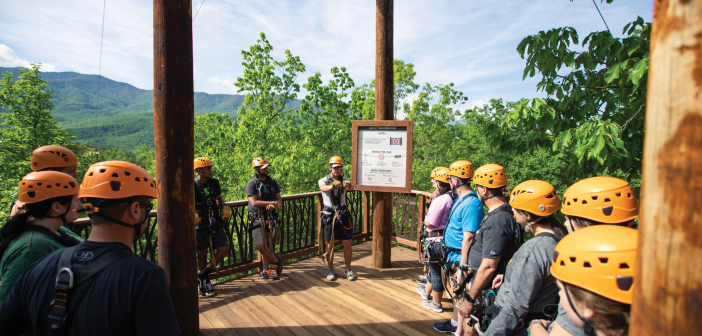Finding the right team to operate your aerial adventure activity is crucial but not always easy. Like other recreation businesses, the aerial adventure world struggles to find reliable employees who will stay for more than a seasonal stint.
Many operators are finding it is more and more important to retain at least some trained staff—especially aerial guides—to keep business consistent and successful. In recent years, some outfits have started to offer partially subsidized employee housing and other perks in response to the lack of affordable housing and increased cost of living.
Adventure Park Insider contacted a variety of aerial adventure operators, including those with zip lines, ropes courses, and canopy tours, to gather their best practices for navigating the seasonal employment landscape. Here’s what we learned about keeping and training seasonal employees, including how hiring international workers can help fill staffing voids.
Employee Housing
It’s not easy to organize employee housing, but it’s well worth the cost and effort. And housing benefits don’t have to be large scale to have a big impact. At Hawaii’s Kohala Zipline, for example, manager Kanoe Lewis says employee housing subsidies made it possible to obtain quality applicants and secure a great team for its upcoming busy season.
Subsidized housing. In previous years, Kohala, located on the Big Island, would reimburse employees for their flight cost to Hawaii after a 30-day probation period, but housing had to be secured by the employee. Just last year, though, Kohala offered employee housing benefits for the first time, mainly to attract two experienced guides who had responded to a seasonal worker ad on Facebook and were offered subsidized housing as an incentive.
Kohala operations manager Daniel Tuck says the housing benefit played a role in securing the experienced guides. “The housing market is really tough out here,” says Tuck. “We have to subsidize the rent by 33 percent to make it competitive for employees to be able to afford to live here.”
He says Kohala lucked out in finding a timely rental vacancy at an affordable cottage nearby.
“It was nice to have the option of bringing in skilled labor,” Tuck says, adding that the two new hires could start guiding sooner, since they could complete a two-day training compared to the usual five.
Own your own. Located one hour north of Duluth in Silver Bay, Minn., North Shore Adventure Park owner Alice Tibbetts uses her vacation home to provide lodging for the park’s manager and additional employees as needed. To meet demand, Tibbetts purchased a second, smaller house in January 2023, at which time she also formed Athena North Properties so it could be rented during the off-season.
Staff housing is necessary for Tibbetts’ operation. “I wouldn’t be able to staff without folks from outside the area and international students who need housing,” she says.
Each three-bedroom house is furnished and can accommodate four to five people, who share a bathroom and kitchen. Park staff pay a moderately priced rent plus damage deposit, and Athena North rents to visiting nurses and others in transition when its properties are not being used for North Shore’s employees.
“I have been able to at least break even on the housing,” says Tibbetts, adding that the market was relatively inexpensive at the time of her purchase.

North Shore Adventure Park, Minn., hires local and international staff to meet demand. Upper left: Students with BridgeUSA cultural work exchange visas can bolster staff numbers during the peak season.
Seeing returns. Climb Works Smoky Mountains Zipline Tour, located across the street from Tennessee’s Great Smoky Mountains National Park, bought an apartment complex almost a decade ago to address employee housing. The two buildings are on the same property; each has 12 units and can house about five employees per unit.
Like Tibbetts, “We bought at a good time,” says general manager Mike Murray. “It has been the key to the company’s success in retaining employees.”
Climb Works utilizes 70-plus staff in the summer—many found through the CoolWorks platform—and not many housing options are available in the area. Murray says the tour needs a robust staff during its busy season, when it can see more than 400 visitors a day.
If an employee opts to stay beyond the peak period to cover shoulder seasons and holidays, the company will subsidize their rent, sometimes letting them stay for free, depending on the situation.
For Climb Works, the ROI has paid off. “[Employee housing] was a huge investment,” says Murray, “but we made it back in spades pretty quick.”
International Opportunities
Staff housing has opened the door to hiring internationally for some parks, which in the past was too cumbersome for many operators, partially due to lack of affordable housing.
There are two types of international visas available for foreign talent. The BridgeUSA program (formerly the J-1 visa) is a cultural work exchange program for students that’s operated by the Department of State; and the H-2B visa is a nonimmigrant employment program offered by the Department of Labor.
The lowdown on BridgeUSA. “The industry standard is for the host organization to provide [BridgeUSA visa holders with] housing,” says Renee Clarke, associate recruitment director for Greenheart Exchange, a designated BridgeUSA sponsor program. Students are expected to pay for housing, she adds, but the idea is for them to still make some cash while having a cultural work experience.
There’s no fee for operators to use the program, but they must have a business license, provide a 32-hour work week, workers’ compensation, and access to cultural activities (which often require transportation).
Clarke notes there are inexpensive ways to provide these activities, such as visiting a local animal shelter, having donuts with the mayor, or organizing a potluck dinner once a month.
BridgeUSA visas are typically issued for a four-month period, but “sometimes students will come back year after year,” says Clarke. It can be extremely rewarding to see employees and globally minded employers form relationships and friendships, she adds.
Per government regulations, BridgeUSA visa holders are not allowed to work at hazardous heights. Still, they may be ideal for the many roles that aren’t performed at height.
“The international students can work on our grounds team support or as axe throwing coaches,” says Colin Lynch, park manager at North Shore, which started hiring BridgeUSA (then J-1) visa students a couple of years ago.
Local vs. international. Of course, hiring locals is a popular option for park operators since they don’t need housing. And it’s important as a business to have a presence in the community by hiring staff that lives there. “It’s crucial to have local loyalty, and our parent company recognizes that,” says Kohala’s Tuck.
But staffing exclusively from the local pool comes with its challenges—particularly with high school- and college-aged employees who get pulled away for the annual family vacation or need to return to school, leaving businesses scrambling to hire a second wave.
“It is difficult to keep locals, as they tend to come and go,” says Lynch. So North Shore uses CIEE, one of the largest BridgeUSA visa sponsor organizations, to secure students from countries all over the world.

Climb Works Smoky Mountains Zipline Tour needs a large staff to meet demand, which can reach 400 visitors a day in peak season.
H-2B visas are another option to secure international workers, one with slightly different parameters. “H-2B workers can stay for the duration of an organization’s season, and they tend to be a higher-level worker,” says Keith Pabien, CEO of Seasonal Connect, an aptly-named platform that helps connect seasonal employers with seasonal workers, and vice versa.
The H-2B program allows many U.S. employers to bring foreign nationals to the United States to fill temporary nonagricultural jobs for up to a year. Unlike the BridgeUSA program, applicants are not students, but workers pursuing a specific career. The visa application process takes about six months and requires financial sponsorship, but the investment can be worth it if a business can get the same employee to return year after year and/or have a consistent and reliable workforce for its busy season.
Staff Expenses, Incentives
“Juggling employees is the hardest part of the job,” says Lee Kerfoot, owner of Kerfoot Canopy Tour and Brainerd Zipline Tour, both in Minnesota. To attract and retain employees, “We try to promote and push that we have a strong referral bonus,” he says. The park has struggled to find guides, says Kerfoot, which is why he recently bumped the referral bonus up to $400.
Bonuses on bonuses. North Shore offers staff referral bonuses, too. It also offers end-of-season bonuses if an employee stays to cover the shoulder season, and has restructured its friends and family passes for employees so they can be used even when the employee is working.
In Hawaii, Kohala Ziplines paid substantial bonuses in January 2023, ranging from $1,500 to $2,000, depending on whether an employee worked full or part time. Plus, everyone on staff got a $1 raise.
“The year 2022 was really good,” says Tuck, which enabled the company to reinvest in its employees. This year was not as strong, with weather shutdowns and longer, deeper slumps in visitation. “Hopefully [a bonus]still happens.”
Kerfoot notes that small gestures can also go a long way. “We try to make people feel like an important part of the team,” he says. For example, $25 gas gift cards have been a popular reward for employees who go above and beyond.
Expenses. Guide training is a significant investment as well. “The time and energy spent on training and safety is one of the biggest expenses,” notes Tuck. Of Kohala’s 22-person staff, 17 are guides, and new guides are typically put through a 60+ hour training program followed by written and skills exams.
At Climb Works, most of its employees are guides who must undergo four on-course days of training and conduct tours with a trained overstudy. “They do this until they can safely execute two full tours on their own,” says Murray.
Given the extensive nature of such training, it’s worth it to invest in employee retention. Climb Works offers medical benefits to its full-time employees as well as referral bonuses—a win-win for both employee and employer.
“Some of our lead guides have been here a long time,” notes Murray.
Camaraderie matters too. “We have a cool vibe that sets the tone for the whole adventure,” says Tuck. “Crews try to outdo each other, pumping each other up and encouraging guests to shout ‘chee-hoo!’, the Hawaiian ‘yee-haw!’”
Making Strides
All the operators agreed that even if an employee returns for just one extra season, it contributes bigly to improving the bottom line and the guest experience.
And although employee turnover in this business is inevitable, these businesses are utilizing best practices to chip away at this stumbling block. As the industry changes, aerial activity operators are adopting new strategies—providing affordable housing, offering perks, and supplementing staff through international workers—to improve hiring and turnover.






